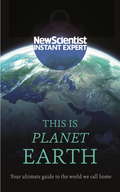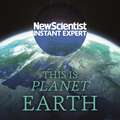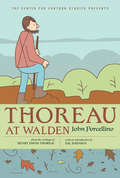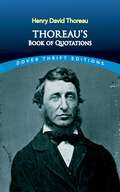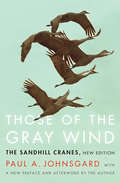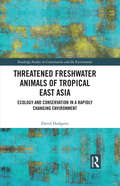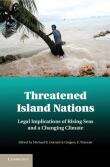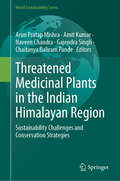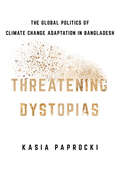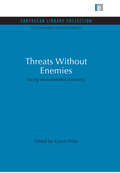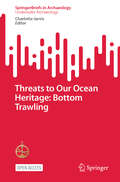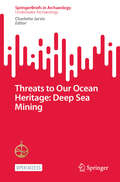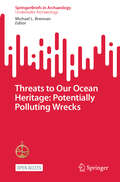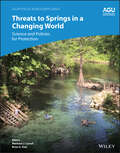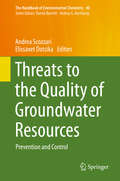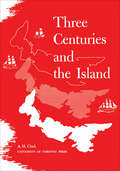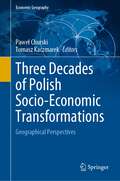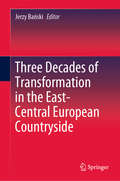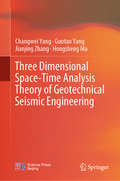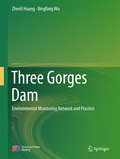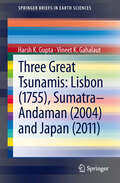- Table View
- List View
This is Planet Earth: Your ultimate guide to the world we call home (New Scientist Instant Expert)
by New ScientistThe ancient Greeks called it Gaia; the Romans Terra. We know it simply as Earth, the planet we call home. And what a planet it is.Formed around 4.6 billion years ago from the debris of the big bang and long-dead stars, at first it was nothing special, but somehow it evolved to become the most amazing place in the known Universe. The only living planet we know of, it also has a very unusual moon, a remarkably dynamic surface, a complex atmosphere and a deeply mysterious interior.This is Planet Earth is dedicated to the wonders of Planet Earth. Its past is long and dramatic and its future shrouded in mystery. Yet despite centuries of research, only now are we starting to understand Earth's complexity.ABOUT THE SERIESNew Scientist Instant Expert books are definitive and accessible entry points to the most important subjects in science; subjects that challenge, attract debate, invite controversy and engage the most enquiring minds. Designed for curious readers who want to know how things work and why, the Instant Expert series explores the topics that really matter and their impact on individuals, society, and the planet, translating the scientific complexities around us into language that's open to everyone, and putting new ideas and discoveries into perspective and context.
This is Planet Earth: Your ultimate guide to the world we call home (New Scientist Instant Expert)
by New ScientistThis Is Planet Earth is dedicated to the wonders of Planet Earth, the most amazing place in the known Universe.The ancient Greeks called it Gaia; the Romans Terra. We know it simply as Earth, the planet we call home. And what a planet it is.Formed around 4.6 billion years ago from the debris of the big bang and long-dead stars, at first it was nothing special, but somehow it evolved to become the most amazing place in the known Universe. The only living planet we know of, it also has a very unusual moon, a remarkably dynamic surface, a complex atmosphere and a deeply mysterious interior.This is Planet Earth is dedicated to the wonders of Planet Earth. Its past is long and dramatic and its future shrouded in mystery. Yet despite centuries of research, only now are we starting to understand Earth's complexity.ABOUT THE SERIESNew Scientist Instant Expert books are definitive and accessible entry points to the most important subjects in science; subjects that challenge, attract debate, invite controversy and engage the most enquiring minds. Designed for curious readers who want to know how things work and why, the Instant Expert series explores the topics that really matter and their impact on individuals, society, and the planet, translating the scientific complexities around us into language that's open to everyone, and putting new ideas and discoveries into perspective and context.(P)2018 Hodder & Stoughton Limited
Thomas Berry, Dreamer of the Earth: The Spiritual Ecology of the Father of Environmentalism
by Ervin Laszlo Allan CombsA tribute to the visionary contributions and prophetic writings of Thomas Berry, spiritual ecologist and father of environmentalism • Contains 10 essays by eminent philosophers, thinkers, and scientists in the field of ecology and sustainability, including Matthew Fox, Joanna Macy, Duane Elgin, Sean Esbjörn-Hargens, Ervin Laszlo, and Allan Combs • Calls for a transformation of consciousness to resolve today’s global ecological and human challenges • Includes a little-known but essential essay by Thomas Berry When cultural historian and spiritual ecologist Thomas Berry, described by Newsweek magazine as “the most provocative figure among the new breed of eco-theologians,” passed away in 2009 at age 94, he left behind a dream of healing the “Earth community.” In his numerous lectures, books, and essays, Berry proclaimed himself a scholar of the earth, a “geologian,” and diligently advocated for a return to Earth-based spirituality. This anthology presents 10 essays from leading philosophers, scientists, and spiritual visionaries--including Matthew Fox, Joanna Macy, Duane Elgin, Sean Esbjörn-Hargens, Ervin Laszlo, and Allan Combs--on the genius of Berry’s work and his quest to resolve our global ecological and spiritual challenges, as well as a little-known but essential essay by Berry himself. Revealing Berry’s insights as far ahead of their time, these essays reiterate the radical nature of his ideas and the urgency of his most important conclusion: that money and technology cannot solve our problems, rather, we must reestablish the indigenous connection with universal consciousness and return to our fundamental spontaneous nature--still evident in our dreams--in order to navigate our ecological challenges successfully.
Thomas Berry: A Biography (G - Reference, Information And Interdisciplinary Subjects)
by Mary Evelyn Tucker John Grim Andrew AngyalThomas Berry (1914–2009) was one of the twentieth century’s most prescient and profound thinkers. As a cultural historian, he sought a broader perspective on humanity’s relationship to the earth in order to respond to the ecological and social challenges of our times. This first biography of Berry illuminates his remarkable vision and its continuing relevance for achieving transformative social change and environmental renewal.Berry began his studies in Western history and religions and then expanded to include Asian and indigenous religions, which he taught at Fordham University, Barnard College, and Columbia University. Drawing on his explorations of history, he came to see the evolutionary process as a story that could help restore the continuity of humans with the natural world. Berry urged humans to recognize their place on a planet with complex ecosystems in a vast, evolving universe. He sought to replace the modern alienation from nature with a sense of intimacy and responsibility. Berry called for new forms of ecological education, law, and spirituality, as well as the creation of resilient agricultural systems, bioregions, and ecocities. At a time of growing environmental crisis, this biography shows the ongoing significance of Berry’s conception of human interdependence with the earth as part of the unfolding journey of the universe.
Thomas-Fermi Model for Mesons and Noise Subtraction Techniques in Lattice QCD (Springer Theses)
by Suman BaralThis thesis make significant contributions to both the numerical and analytical aspects of particle physics, reducing the noise associated with matrix calculations in quantum chromodynamics (QCD) and modeling multi-quark mesonic matters that could be used to investigate particles previously unseen in nature. Several methods are developed that can reduce the statistical uncertainty in the extraction of hard-to-detect lattice QCD signals from disconnected diagrams. The most promising technique beats competing methods by 1700 percent, leading to a potential decrease in the computation time of quark loop quantities by an order of magnitude. This not only increases efficiency but also works for QCD matrices with almost-zero eigenvalues, a region where most QCD algorithms break down. This thesis also develops analytical solutions used to investigate exotic particles, specifically the Thomas-Fermi quark model, giving insight into possible new states formed from mesonic matter. The main benefit of this model is that it can work for a large number of quarks which is currently almost impossible with lattice QCD. Patterns of single-quark energies are observed which give the first a priori indication that stable octa-quark and hexadeca-quark versions of the charmed and bottom Z-meson exist.
Thoreau at Walden (The Center for Cartoon Studies Presents)
by John Porcellino"I am convinced, both by faith and experience, that to maintain one's self on this earth is not a hardship, but a pastime, if we will live simply and wisely." So said Henry David Thoreau in 1845 when he began his famous experiment of living by Walden Pond. In this graphic masterpiece, John Porcellino uses only the words of Thoreau himself to tell the story of those two years off the beaten track. The pared-down text focuses on Thoreau's most profound ideas, and Porcellino's fresh, simple pictures bring the philosopher's sojourn at Walden to cinematic life. For readers who know Walden intimately, this graphic treatment will provide a vivid new interpretation of Thoreau's story. For those who have never read (or never completed!) the original, it presents a contemporary look at a few brave words to live by.
Thoreau: A Book of Quotations (Dover Thrift Editions: Speeches/quotations Ser.)
by Henry David Thoreau Bob BlaisdellTo Emerson and other New England transcendentalists who knew him best, Thoreau often seemed prickly and antisocial. But in his writings he was (and is) a man anyone would treasure as a friend, sounding board, and spiritual advisor -- a man who trafficked in that rarest of commodities, the truth. Even now, almost 140 years after his death, his voice remains clear and compelling, and his truths are as relevant and meaningful as they were in his lifetime.In this treasury of more than 450 striking, thought-provoking excerpts from his writing, you will hear him railing against injustice, giving voice to his love of nature, and advocating the simplicity and conscious living that he brought to fruition during his two-year stay at Walden Pond. "To be serene and successful we must be at one with the universe." "Our life is frittered away by detail.... Simplify, simplify."Grouped under 17 headings, including "Education," "Freedom and Individualism," "Friendship and Love," "Human Nature," "Literature and Writing," "Nature," "Season," and "Solitude," the quotations include such favorites as "The mass of men lead lives of quiet desperation" and "Some circumstantial evidence is very strong, as when you find a trout in the milk." Whatever category they are in, Thoreau's observations provide so much inspiration and intellectual nourishment that browsing through this book becomes an exciting voyage of discovery into the heart of the human condition.
Those of the Gray Wind: The Sandhill Cranes, New Edition
by Paul A. JohnsgardWith Paul A. Johnsgard, we follow the migration of the sandhill cranes from the American Southwest to their Alaskan breeding grounds and back again, an annual pattern that has persisted over millions of years. By selecting four historic time frames of the migration between 1860 and 1980, Johnsgard illustrates how humans have influenced the flocks and how different American cultures have variously responded to the birds and perceived their value. Each section focuses on the interactions between children of four different American cultures and sandhill cranes, triggered by events occurring during the annual life cycle of the cranes. The story is enriched by the author’s exquisite illustrations, by Zuni prayers, and by Inuit and Pueblo legends. With a new preface and afterword and a new gallery of photographs by the author, Those of the Gray Wind is a classic story of a timeless ritual that can be enjoyed for generations to come.
Threatened Freshwater Animals of Tropical East Asia: Ecology and Conservation in a Rapidly Changing Environment (Routledge Studies in Conservation and the Environment)
by David DudgeonThis book offers a comprehensive account of the current state of inland waters in tropical and subtropical East Asia, exploring a series of case studies of freshwater fish, reptiles, amphibians, birds, mammals and water bodies at particular risk. The book highlights the rich freshwater biodiversity of tropical East Asia and draws attention to the various threats it faces due to human activities and rapid environmental change. It addresses the question of whether the contributions of these animals and habitats, or biodiversity in general, to ecosystem functioning and service provision provide sufficient basis for arguments supporting nature conservation. Drawing on instances from the rivers and lakes of tropical East Asia, the book also asks whether the benefits accruing from intact ecosystems are likely to be enough to ensure their preservation. If the answer to either or both these questions is ‘no’, then what are the prospects for freshwater biodiversity in rapidly changing tropical East Asia? This book will be of interest to students and scholars of biodiversity, conservation, freshwater ecology, ecosystem services and Asian Studies.
Threatened Island Nations
by Michael B. Gerrard Gregory E. WannierRising seas are endangering the habitability and very existence of several small island nations, mostly in the Pacific and Indian oceans. This is the first book to focus on the myriad legal issues posed by this tragic situation: If a nation is under water, is it still a state? Does it still have a seat at the United Nations? What becomes of its exclusive economic zone, the basis for its fishing rights? What obligations do other nations have to take in the displaced populations, and what are these peoples' rights and legal status once they arrive? Should there be a new international agreement on climate-displaced populations? Do these nations and their citizens have any legal recourse for compensation? Are there any courts that will hear their claims, and based on what theories? Leading legal scholars from around the world address these novel questions and propose answers.
Threatened Medicinal Plants in the Indian Himalayan Region: Sustainability Challenges and Conservation Strategies (World Sustainability Series)
by Amit Kumar Gajendra Singh Naveen Chandra Chaitanya Baliram Pande Arun Pratap MishraThe book provides an in-depth analysis of the major issues related to the conservation of threatened medicinal plants in the Indian Himalayan region. The book is a comprehensive resource and sustainability of challenges and conservation strategies that highlights the critical role of medicinal plants in traditional healthcare systems and identifies the significant threats that these plants face due to various anthropogenic and natural factors. The book covers ten major themes that are critical to understanding the sustainability conservation of threatened medicinal plants in the Indian Himalayan region. It provides an essential resource for researchers, policymakers, and practitioners interested in the sustainability conservation of threatened medicinal plants in the Himalayan area. The book provides an overview of the major issues related to medicinal plant sustainability conservation and suggests strategies for the sustainable management of these plants. The authors have provideda comprehensive and insightful analysis of the sustainability conservation status of medicinal plants in the region, highlighting the urgent need for concerted efforts to conserve these valuable resources.
Threatening Dystopias: The Global Politics of Climate Change Adaptation in Bangladesh (Cornell Series on Land: New Perspectives on Territory, Development, and Environment)
by Kasia PaprockiBangladesh is currently ranked as one of the most climate vulnerable countries in the world. In Threatening Dystopias, Kasia Paprocki investigates the politics of climate change adaptation throughout the South Asian nation. Drawing on ethnographic and archival fieldwork, she engages with developers, policy makers, scientists, farmers, and rural migrants to show how Bangladeshi and global elites ignore the history of landscape transformation and its attendant political conflicts. Paprocki looks at how groups craft economic narratives and strategies that redistribute power and resources away from peasant communities. Although these groups claim that increased production of export commodities will reframe the threat of climate change into an opportunity for economic development and growth, the reality is not so simple. For the country's rural poor, these promises ring hollow. As development dispossesses the poor from agrarian livelihoods, outmigration from peasant communities leads to precarious existences in urban centers. And a vision of development in which urbanization and export-led growth are both desirable and inevitable is not one the land and its people can sustain. Threatening Dystopias shows how a powerful rural movement, although hampered by an all-consuming climate emergency, is seeking climate justice in Bangladesh.
Threats Without Enemies: Facing environmental insecurity (Sustainable Development Set)
by Gwyn PrinsThe world is moving into a new era which will be dominated by a new range of threats and a new range of priorities. Already headlines tell of storms and droughts, mass emigrations, the danger of old Soviet nuclear reactors and the thinning ozone layer, and with the menaces of global warming, deforestation, pollution and loss of biodiversity, the picture is likely to get bleaker. Unlike traditional threats, these are not made deliberately and standard military responses are usually inappropriate They are threats without enemies and they present quite new and fundamental challenges to the international community which has to find new methods and institutions, as well as the resolve, to tackle them. In this book, eminent experts describe the new threats and the scale of the dangers which they present and set out the political, military and institutional changes needed. Gwyn Prins is Director of the Global Security Programme at the University of Cambridge. He is author of Top guns and Toxic Whales, also published by Earthscan. Progress For A Small Planet Three topics dominate discussions of the global environment: pollution; the consequences of the affluent running ever faster through finite resources; and the growing tensions between rich and poor as a third of humanity continues to live and die in desperate poverty. In this exceptional book Barbara Ward (co-author with Rene Dubos of the bestselling Only One Earth) refused to see these processes as inevitable. It describes new technologies for recycling waste, for energy, for 'getting more for less' ,linking them to ordinary people's working lives. It also suggests a strategy for meeting the basic needs of the disadvantaged, and shows how the vast inequalities between countries can be reduced. This perceptive survey of policies outlines a planetary bargain between the world's nations that would guarantee individual freedom from poverty and keep our shared biosphere in good working order. Originally published in 1993
Threats to Our Ocean Heritage: Bottom Trawling (SpringerBriefs in Archaeology)
by Charlotte JarvisThis open access book focuses on the destruction of our Ocean Heritage from bottom trawling. It brings together the natural and cultural sides of the marine environment to further our understanding of the importance of this heritage, how it is threatened by activities such as bottom trawling, and provides recommendations, such as a moratorium in particularly vulnerable areas that are currently unprotected. It is a unique publication in integrating cultural heritage into a discussion where the primary focus has been the destruction of natural heritage The book is divided into three sections that discuss, respectively, the international legal context, history and ecological impact of bottom trawling, case studies highlighting the impact of these destructive activities on underwater cultural heritage, and finally recommended future steps and how to use the damage presented here to halt future devastation. This book is a valuable tool for resource managers and representatives of governments and international organizations in their efforts to establish the moratoria called for. This book is also of interest to educators, archaeologists and practitioners working in the field of underwater cultural heritage. This is an open access book.
Threats to Our Ocean Heritage: Deep Sea Mining (SpringerBriefs in Archaeology)
by Charlotte JarvisThis open access brief is a pioneering work that is one of the first book publications to cover underwater cultural heritage and deep seabed mining. Bringing together a variety of perspectives, the work is designed to serve several purposes and educate a few different types of readers. The work introduces and offers a history on deep seabed mining, the legal context, and how it fits into the new UN Convention on Law of the Sea on the Conservation and Sustainable Use of Marine Biological Diversity of Areas beyond National Jurisdiction (BBNJ treaty), the International Seabed Authority (DSM governing body), and the ecological impacts of deep seabed mining. The brief is also aimed at marine ecologists and other ocean scientists who may already be aware of the DSM and the ecological impacts, but not of the cultural heritage at risk. It introduces deep-water archaeology to them and a few case studies of heritage at risk, like in New Zealand or polluting wrecks. Finally, the book offers suggestions for steps forward and case studies of cultural heritage being included in environmental impact assessments. By the end of the book, all parties should feel educated enough to begin championing a ban on, or more regulations for, seabed mining. One additional strength of the book is that it gives voice to those without a traditional academic background. Intangible cultural heritage has been a hotbed issue in mining regulations and many indigenous voices, especially from the Pacific, have been loudly outspoken at the ISA. While writing thousand-word academic journal articles was not in their wheelhouse, they have given permission for their speeches to be transcribed and included in the book. This will bring a new set of voices into the scientific discourse on the issue. The book is also set up to have many images to de-mystify the deep and show readers the beauty that must be protected.
Threats to Our Ocean Heritage: Potentially Polluting Wrecks (SpringerBriefs in Archaeology)
by Michael L. BrennanThis open access volume focuses on the environmental hazards and cultural significance of Potentially Polluting Wrecks (PPWs), and how mitigation efforts have assisted in documenting and preserving the history of these sites. It is an important resource on the subject of Potentially Polluting Wrecks that synthesizes previously published information that was not academically or scientifically produced. This includes numerous international studies of shipwreck databases and threats posed by world war wrecks containing oil and other hazardous materials that could spill. This book evaluates these materials and presents new analyses and investigations with modern technology that assist in locating, documenting, and remediating polluting wreck sites. Consequently, this volume calls for increased ocean exploration missions to locate sunken merchant vessels that may pose pollution hazards and site assessments to determine any potential risks. This book is of interest to government officials, educators, archaeologists and practitioners working in the field of underwater archaeology. This is an open access book.
Threats to Springs in a Changing World: Science and Policies for Protection (Geophysical Monograph Series)
by Brian G. Katz Matthew J. CurrellThreats to Springs in a Changing World Threats to Springs in a Changing World Science and Policies for Protection Anthropogenic causes, including climate change, have been degrading springs around the world. Changes in spring water quality and flow impact human health, cultural values, ecology, and livelihoods. Threats to Springs in a Changing World: Science and Policies for Protection presents a range of international studies illustrating the causes of spring degradation and strategies being used to safeguard springs both now and for the future. Volume highlights include: Examples of threatened springs in diverse hydrogeologic settingsInnovative methods and tools for understanding the hydrogeology of spring systemsCurrent policy and governance approaches for alleviating damage to springsDifferent approaches to management of springsA call for practitioners, policy makers, scientists, and the public to work together The American Geophysical Union promotes discovery in Earth and space science for the benefit of humanity. Its publications disseminate scientific knowledge and provide resources for researchers, students, and professionals.
Threats to the Quality of Groundwater Resources
by Andrea Scozzari Elissavet DotsikaThis book focuses on scientific and technological aspects of groundwater-resources assessment and surveillance. It describes relevant risks and investigates selected techniques for the monitoring and mitigation of the individuated threats to groundwater quality. The authors discuss the concepts of groundwater-resources protection and offer examples of both geogenic and anthropogenic degradation of groundwater quality, such as heavy metals from mining activities and natural water-rock interactions, as well as risk of contamination due to geological CO2 storage practices etc. The volume also covers non-invasive monitoring techniques and briefly addresses innovative sensor technologies for the online assessment of water quality. Furthermore, the role played by geochemical techniques, the potential of environmental isotopes and the support provided by physical modelling are highlighted. The chapters guide the reader through various viewpoints, according to the diverse disciplines involved, without aiming to be exhaustive, but instead picking representative topics for their relevance in the context of groundwater protection and control. This book will be of interest to advanced students, researchers, policy-makers and stakeholders at various levels.
Three Centuries and the Island
by Andrew Hill ClarkThis study is one of the first in the field of historical geography to be published in Canada. Written after exhaustive research, it uses a particular approach to the study of historical agricultural geography which concentrates on the use of basic distributional evidence for the description and interpretation of the changing character of any region through any period of time. By the analysis of over 1200 maps, some of which form part of the text of the book, Professor Clark studies agriculture as the dominant economic activity of Prince Edward Island and traces with remarkable clarity through the changing patterns of land culture throughout the province.The book begins with a description of the natural geography of the Island which, despite its small size, shows surprising variety. It goes on to prove the necessity for careful consideration of the background of habit and prejudice of groups of different origin when studying the changing geographies of land use.The settlement of the Island is traced from the time it was used as a summer campground by the Micmac Indians. Details of the arrival of the first Acadians, the transfer to British rule, and the subsequent influx of Scottish, Irish, Loyalist, and English stock are given together with evidence of the effect their coming had on the agriculture of the region. One hundred and fifty-five maps and sixteen tables to illustrate the distribution of population by area and origin, changes in kind and distribution of crops, census of livestock, etc., from the early eighteenth century to the present day, and from the days when the potato was unknown as a crop through the fur-farming era.The author presents this study as part of his life-work, a programme of research on the settlement overseas in the seventeenth, eighteenth, and nineteenth centuries of the people from the British Isles. He is descended from Prince Edward Island settlers and writes of the province from a background of personal knowledge of, and affection for, the land of his forbears.
Three Decades of Polish Socio-Economic Transformations: Geographical Perspectives (Economic Geography)
by Paweł Churski Tomasz KaczmarekThis edited volume analyses and discusses the systematisation of Polish socio-economic transformations of the last three decades using selected examples of the most important changes. 1989 marked the onset of the political transformation process in Poland and other countries of Central and Eastern Europe. The transition involved a shift from a socialist system to a parliamentary democracy and from a command economy to a market one. Due to the deep economic crisis that culminated in 1988 and the peaceful model of change developed and implemented in Poland, the magnitude and manner of implementing various initiatives was unprecedented and had specific implications. This transformation opened Polish society and the Polish economy to the impact of global social and economic changes, triggering successive transformations, often overlapping in terms of their causes and consequences. This publication aims to present the course and effects, in particular territorial, of Poland's socio-economic transformation in the years 1990–2020. The analysis covers the key aspects of this transformation, illustrated with references to the concepts and theories of development, domestic and foreign literature, own empirical research and existing or newly developed model approaches to transformation in the territorial dimension. The book appeals to researchers and student in the fields of geography, spatial management, economics and business, sociology and political sciences, public and private economic research institutes, employees of governmental bodies and corporations, consultants in public administration, journalists and policymakers.
Three Decades of Transformation in the East-Central European Countryside
by Jerzy BańskiThis book identifies, diagnoses and evaluates social and economic processes taking place in the rural areas of Central and Eastern Europe (CEE) states in the last 25 years and affecting the immediate future, with a particular focus on their spatial diversity. It addresses questions related to the rationality of the current development policy and possible results in the future. Contemporary processes of socio-economic development are typified by the fact that spatial and regional disparities are tending to increase. This unfavourable phenomenon manifested both in society and in terms of polarised space needs to be counteracted using an effective development policy. The book highlights issues concerning demography, functional structure and non-agricultural activity, and identifies new challenges arising from membership of the European Union (EU). Accession to the EU and the opportunity to implement support measures has further increased the dynamism of transformation – a process that proceeded under various scenarios and different regulations and assumptions that have yet to be identified and evaluated. Furthermore, the current internal policies of individual CEE states concerning rural areas are diverse and likely to affect differential future development. The book is based on the knowledge and experience of scientists from countries in the region investigated, who have the best understanding of the subject matter and have observed the transformations. It is intended for researchers exploring the development of the countryside and practitioners dealing with regional and national development policies targeting rural areas.
Three Dimensional Space-Time Analysis Theory of Geotechnical Seismic Engineering
by Changwei Yang Guotao Yang Jianjing Zhang Hongsheng MaWritten by respected experts, this book presents essential findings on the Wenchuan earthquake. It establishes a series of time–frequency analysis methods, and subsequently applies them to the layered site, slope, and earth-retaining wall. Further, it examines various cases and their solutions, and shares the results of numerous shaking-table tests and numerical simulations. As such, it is a valuable resource for researchers and engineers in the fields of geotechnical engineering and anti-seismic engineering.
Three Gorges Dam
by Zhenli Huang Bingfang WuThis is the first English book talking about the Three Gorges Project Eco-Environmental Monitoring System (TGPEEMS). It presents lessons learned in construction of large dam projects at home and abroad in this field, identifies existing problems before suggesting a scientific improvement plan. and, most importantly, it studies modification of the TGPEEMS to adapt it to the changing situation after the impoundment of the reservoir, and provides an essential overview of measures and progress in the ecological and environmental protection for the ongoing project. As such, it offers a valuable reference guide for both researchers and environmental decision-makers. Prof. Zhenli Huang works at the National Research Center for Sustainable Hydropower Research, China Institute of Water Resources and Hydropower Research. Prof. Bingfang Wu works at the Institute of Remote Sensing Applications, Chinese Academy of Sciences, China.
Three Great Tsunamis: Lisbon (1755), Sumatra-Andaman (2004) and Japan (2011)
by Harsh K. Gupta Vineet K. GahalautTsunamis are primarily caused by earthquakes. Under favourable geological conditions, when a large earthquake occurs below the sea bed and the resultant rupture causes a vertical displacement of the ocean bed, the entire column of water above it is displaced, causing a tsunami. In the ocean, tsunamis do not reach great heights but can travel at velocities of up to 1000 km/hour. As a tsunami reaches shallow sea depths, there is a decrease in its velocity and an increase in its height. Tsunamis are known to have reached heights of several tens of meters and inundate several kilometres inland from the shore. Tsunamis can also be caused by displacement of substantial amounts of water by landslides, volcanic eruptions, glacier calving and rarely by meteorite impacts and nuclear tests in the ocean. In this SpringerBrief, the causes of tsunamis, their intensity and magnitude scales, global distribution and a list of major tsunamis are provided. The three great tsunamis of 1755, 2004 and 2011are presented in detail. The 1755 tsunami caused by the Lisbon earthquake, now estimated to range from Mw 8.5 to 9.0, was the most damaging tsunami ever in the Atlantic ocean. It claimed an estimated 100,000 human lives and caused wide-spread damage. The 2004 Sumatra Andaman Mw 9.1 earthquake and the resultant tsunami were the deadliest ever to hit the globe, claiming over 230,000 human lives and causing wide-spread financial losses in several south and south-east Asian countries. The 2011 Mw 9.0 Tohoku-Oki earthquake and the resultant tsunami were a surprise to the seismologists in Japan and around the globe. The height of the tsunami far exceeded the estimated heights. It claimed about 20,000 human lives. The tsunami also caused nuclear accidents. This earthquake has given rise to a global debate on how to estimate the maximum size of an earthquake in a given region and the safety of nuclear power plants in coastal regions. This Brief also includes a description of key components of tsunami warning centres, progress in deploying tsunami watch and warning facilities globally, tsunami advisories and their communication, and the way forward.
Three Marjories: Marjory Stoneman Douglas, Marjorie Kinnan Rawlings, Marjorie Harris Carr and their Contributions to Florida
by Sandra Wallus SammonsFlorida is lucky to have had three women — three Marjories — speaking out about saving Florida's natural environment.Marjory Stoneman Douglas is known as the &“Mother of the Everglades.&” She wrote The Everglades: River of Grass, the seminal and now classic book on this unique region of south Florida. She was a tireless campaigner for the environment and helped make the Everglades a national park. Marjorie Kinnan Rawlings is best known for her books set in Florida: The Yearling, Cross Creek, and South Moon Under, all set in the then-remote wilderness of central Florida. Her very popular books brought the world's attention to the importance of the culture and natural environment of this region. Marjorie Harris Carr fought to save the Oklawaha River by challenging the building of the Cross Florida Barge Canal. She argued that this would cut the ecology of the state in two, particularly ruinous for the wildlife. Now there is the Marjorie Harris Carr Cross Florida Greenway, which serves as a bridge for wildlife through developed areas and over I-75.
